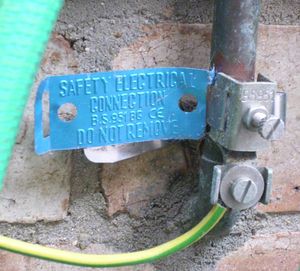Difference between revisions of "Bathroom electrics"
Jump to navigation
Jump to search
(→Supplementary bonding: Clarify impact of 17th edtn relaxation on SEQ bonding) |
|||
| Line 41: | Line 41: | ||
[[image:equi bond outdoor 1537-2.jpg|thumb|outdoor equipotential bonding clamp]] | [[image:equi bond outdoor 1537-2.jpg|thumb|outdoor equipotential bonding clamp]] | ||
| − | + | Unless an installation complies with the latest requirements of the 17th edition (i.e. all required main equipotential bonding is installed, and additional protection for all circuits used in the bath / shower room is provided by a [[RCD]] with trip current of 30mA or less) then supplementary equipotential bonding is required. | |
| − | |||
| − | |||
| + | See [[Earthing and Bonding]] for more detail. | ||
==Showers== | ==Showers== | ||
Revision as of 01:20, 21 July 2009
There are extra considerations for electrical wiring in a bathroom.
Article currently incomplete.
Zones
Bathrooms are divided into zones for electrical purposes.
Zone 0
- The interior of the bath or shower
- Electrical appliances here must be IPX7
- Electrical appliances here must run on SELV at a maximum of 12v ac or 30v dc
Zone 1
- area directly above zone 0, upto a height of 2.25m above the bath or shower, or to the height of the maximum reach of the shower head if that is greater.
- Electrical appliances must be SELV with the transformer outside all the zones
- Electrical appliances must be IPX4 or better
Zone 2
- area beyond zones 0&1, extends 60cm horizontally and upto 2.25m vertically beyond zones 0&1.
- Also area within 60cm of sinks, plus area directly below this
- Electrical appliances must be IPX4 or better
- Electrical appliances here must run on SELV wth transformer outside the zones
Zone 3
- zone 3 ceased to exist in 2008 with the 17th edition of the wiring regs.
Unzoned
- Outside zone 2
- Under the bath if a tool is required to gain access
- Shaver units permitted
- SELV appliances permitted
- Non-selv portable appliances in bathrooms must be physically prevented from entering zone 2. This is usually done by limiting mains lead length on the appliance.
Unsuitable in all zones
- Some appliances are marked unsuitable for bathrooms
- Some appliances are not thus marked, but are still unsuitable. CRT TVs are one example.
Supplementary bonding
Unless an installation complies with the latest requirements of the 17th edition (i.e. all required main equipotential bonding is installed, and additional protection for all circuits used in the bath / shower room is provided by a RCD with trip current of 30mA or less) then supplementary equipotential bonding is required.
See Earthing and Bonding for more detail.
Showers
Section to be written.
Installing mains electrics in showers is definitely frowned upon. But remarkably, it has been done!
